The Intel Comet Lake Core i9-10900K, i7-10700K, i5-10600K CPU Review: Skylake We Go Again
by Dr. Ian Cutress on May 20, 2020 9:00 AM EST- Posted in
- CPUs
- Intel
- Skylake
- 14nm
- Z490
- 10th Gen Core
- Comet Lake
Core-to-Core Latency: Issues with the Core i5
For Intel’s Comet Late 10th Gen Core parts, the company is creating two different silicon dies for most of the processor lines: one with 10 cores and one with 6 cores. In order to create the 8 and 4 core parts, different cores will be disabled. This isn’t anything new, and has happened for the best part of a decade across both AMD and Intel in order to minimize the number of new silicon designs, and also to build in a bit of redundancy into the silicon and enable most of the wafer to be sold even if defects are found.
For Comet Lake, Intel is splitting the silicon such that all 10-core Core i9 and 8-core Core i7 processors are built from the 10c die, as is perhaps expected, and the 6-core Core i5 and 4-core Core i3 processors are built from the 6c die. The only exception to these rules are the Core i5-10600K/KF processors which will use the 10-core die with four cores disabled, giving six cores total. This leads to a potential issue.
So imagine a 10c die as two columns of five cores, capped on each end by the System Agent (DRAM, IO) and Graphics, creating a ring of 12 stops that data has to go through to reach other parts of the silicon. Let us start simple, and imagine disabling two cores to make an 8c processor. It can be pretty straightforward to guess the best/worst case scenario in order to get the best/worst core-to-core latency
The other worst 8c case might be to keep Core 0 enabled, and then disable Core 1 and Core 2, leaving Core 3-9 enabled.
We can then disable four cores from the original 10 core setup. It can be any four cores, so imagine another worst case and a best case scenario.
On the left we have the absolute best case arrangement that minimizes all core-to-core latency. In the middle is the absolute worst case, with any contact to the first core in the top left being a lot higher latency with more distance to travel from any core. On the right is an unbalanced design, but perhaps a lower variance in latency.
When Intel disables cores to create these 8c and 6c designs, the company has in the past promised that any disabling would leave the rest of the processor ‘with similar performance targets’, and that while different individual units might have different cores disabled, they should all fall within a reasonable spectrum.
So let us start with our Core i5-10600K core-to-core latency chart.
Cores next door seem well enough, then as we make longer trips around the ring, it takes about 1 nanosecond longer for each stop. Until those last two cores that is, where we get a sudden 4 nanosecond jump. It’s clear that the processor we have here as a whole is lopsided in its core-to-core latency and if any thread gets put onto those two cores at the end, there might be some questionable performance.
Now it’s very easy to perhaps get a bit heated with this result. Unfortunately we don’t have an ‘ideal’ 6c design to compare it against, which makes comparisons on performance to be a bit tricky. But it does mean that there is likely to be variation between different Core i5-10600K samples.
The effect still occurs on the 8-core Core i7-10700K, however it is less pronounced.
There’s still a sizeable jump between the 3 cores at the end compared to the other five cores. One of the unfortunate downsides with the test is that the enumeration of the cores won’t correspond to any physical location, so it might be difficult to narrow down the exact layout of the chip.
Moving up to the big 10-core processor yields an interesting result:
So while we should have a steadily increasing latency here, there’s still that 3-4 nanosecond jump with two of the cores. This points to a different but compounding issue.
Our best guess is that these two extra cores are not optimized for this sort of ring design in Comet Lake. For their Core lineup of processors, Intel has been using a ring bus as the principle interconnect between its cores for over a decade, and we typically see them on four and six core processors. Intel also used a ring bus in its enterprise processors for many years, with chips up to 24 cores, however those designs used dual-ring buses in order to keep core-to-core latency down. Intel has put up to 12 cores on a single ring, though broadly speaking the company seems to prefer keeping designs to 8 or fewer cores per ring.
If Intel could do it for those enterprise chips, then why not for the 10 core Comet Lake designs here? We suspect it is because the original ring design that went into consumer Skylake processors, while it was for four cores, doesn’t scale linearly as the core count increases. There is a noticeable increase in the latency as we move from four to six and six to eight core silicon designs, but a ten-core ring is just a step too far, and additional repeaters are required in the ring in order to support the larger size.
There could also be an explanation relating to these cores also having additional function on that section of the ring, such as sharing duties with IO parts of the core, or PCIe lanes, and as a result extra cycles are required for any additional cacheline transfers.
We are realistically reaching the limits of any ring-line interconnect for Intel’s Skylake consumer line processors here. If Intel were to create a 12-core version of Skylake consumer for a future processor, a single ring interconnect won’t be able to handle it without an additional latency penalty, which might be more of a penalty if the ring isn't tuned for the size. There's also a bandwidth issue, as the same ring and memory has to support more cores. If Intel continue down this path, they will either have to use dual rings, use a different interconnect paradigm altogether (mesh, chiplet), or move to a new microarchitecture and interconnect design completely.
Frequency Ramps
We also performed our frequency ramps on all three processors. Nothing much to say here – all three CPUs went from 800 MHz idle to peak frequency in 16 milliseconds, or one frame at 60 Hz. We saw the peak turbo speeds on all the parts.


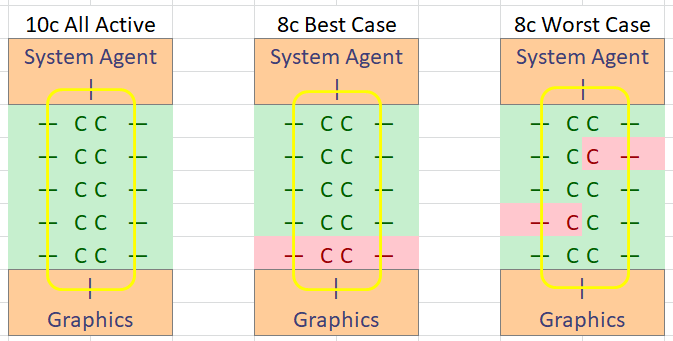
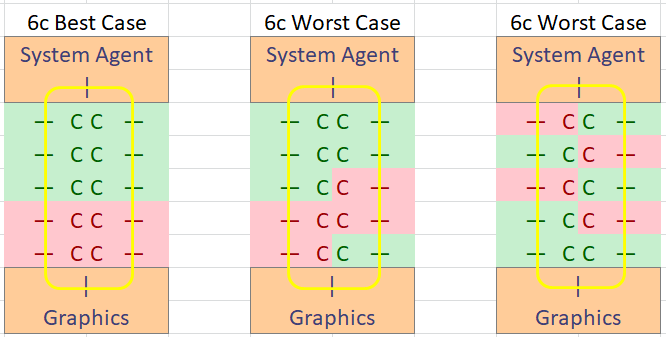
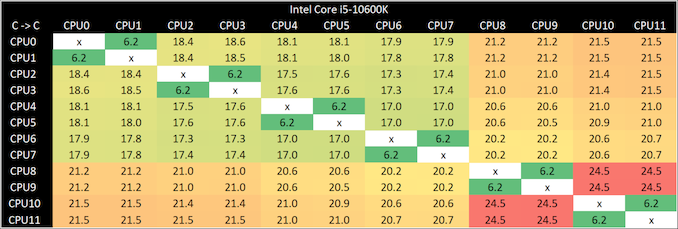



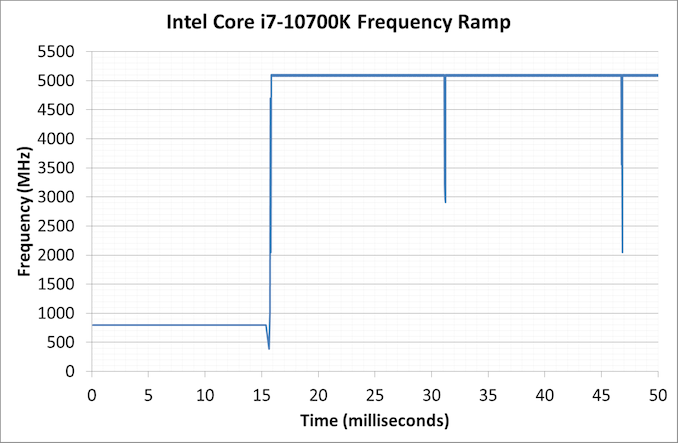
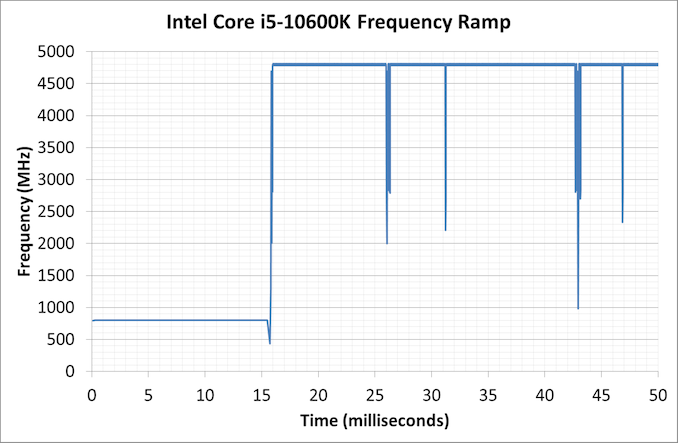








220 Comments
View All Comments
Spunjji - Tuesday, May 26, 2020 - link
Mixed disagree.In all likelihood, Intel is incentivizing OEMs to continue working with their products.
It certainly looks like there is some sort of unspecified agreement between OEMs, Intel and Nvidia - hence the seemingly universal limitation of the 2060 with an AMD CPU.
But then... this absolutely is AMD's first proper crack at a high-end notebook chip that performs up to its billing in a very, very long time. It will take time for it to filter though, so the current state of the market may not be a good indicator - especially with COVID-19 about.
Tunnah - Wednesday, May 20, 2020 - link
Regarding your gaming suite test and GTA V/Steam limitations; why not switch to the cracked, offline version ? It's not like you're pirating it as you already bought it.Also you could keep a monolithic version in which you could insert any scripts you want via the modding capabilities, and because it's offline, updates won't come in and screw up your files. I keep a pirate version separate for messing around with modding on, and I never have to worry about an update rolling things back.
arashi - Sunday, May 24, 2020 - link
I'm sure the legal liability would be very welcome.Hxx - Wednesday, May 20, 2020 - link
im excited for the 10700k for my gaming rig. almost as good as the 10900k but cheaper and less power hungry.HammerStrike - Wednesday, May 20, 2020 - link
The lack of PCIe 4.0 is a deal breaker for any gaming focused box. The one area where the new consoles have an undisputed lead is in their SSD’s and I/O infrastructure. As game engines and game design are transformed by this I think, within a few years, we are going to see game performance improvements with faster SSD’s. Much more so then the few % Intel currently has,based on CPU alone. Which is only really of practical benefit if you have a monitor with 165+ refresh rate and game at those settings. I love a high refresh but I’d much rather have the pretty bells and whistles on and get 80-120hz vs setting everything to low for 165.AMD chips are just much more compelling. Of course, unless you absolutely have to upgrade now, I’d wait a few months for Zen 3. Fair chance they take the performance crown, or get so close as not to matter. Plus they will run a lot cooler - even if you don’t care about the power draw per say, the cooler a chip runs the cheaper / quieter the cooling solution is. Take that savings and put it in a GPU, RAM or PCIe 4.0 SSD.
Boshum - Wednesday, May 20, 2020 - link
I don't think lack of PCIe 4.0 is that bad, but is it certain that the LGA1200 won't support PCIe 4.0 when a Rocket Lake chip is plugged in?WaWaThreeFIVbroS - Thursday, May 21, 2020 - link
The board may support PCIe 4.0 signals but the Z490 chipset doesn't, so when a rocket lake is plugged in the PCIe 4 will probably only came from the CPUImNotARobot - Wednesday, May 20, 2020 - link
I feel like there is a lack of testing between PCIe 4 and 3. The way I look at it, nvidia is right around the corner from launch their PCIe 4 lineup so these processors are going to be powering that. I haven't seen anyone review an AMD 5700xt on an intel and AMD machine just to see what other real life gaming impact that can have. Agreed if you're a hardcore gamer you might not want a 5700xt...but it gives insight on what next gen PCIe 4 channel can get you.haukionkannel - Thursday, May 21, 2020 - link
No impact at all. Todays and near future GPUs Are too weak to saturate pci 3.0... maybe in few years we will get GPUs that Are faster in Pci4.0... but that time has not yet arrived. (Unles you have 4Gb amd 5500 that has narrow 8wide bus.)Pci 4.0 is for m2ssd at this moments!
prophet001 - Thursday, May 21, 2020 - link
Can't really argue but the clock performance does matter a lot in WoW which is what I mainly play. No gen 4.0 is wack but so is 16 lanes into the CPU.